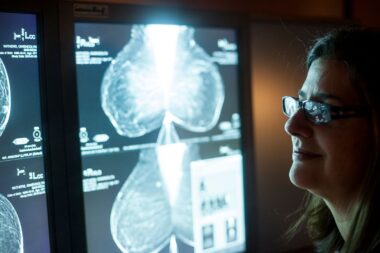There’s a common myth that breast cancer is strictly a women’s health issue. While it’s true that women develop breast cancer at a much higher rate, breast cancer in men is a real and serious condition. In the U.S., about 1% of new breast cancer diagnoses occur in men.
Male Breast Tissue and Risk Factors for Breast Cancer
All people are born with breast tissue that has canals, or ducts, spread throughout the tissue. Similarly, all bodies make estrogen and testosterone. These chemical messengers, or hormones, affect the development and function of many parts of the body. During puberty, increased levels of estrogen cause breast tissue to grow in females, and higher testosterone levels stop breast tissue from developing in males. Still, breast cancer cells can develop in any breast tissue, no matter how little of the tissue there is.
About 1 in 833 men will develop breast cancer. Several factors may increase your risk of developing breast cancer:
- An injured, removed or undescended testicle
- Being age 50 or older
- Family history of breast cancer
- Gynecomastia, a condition where breast tissue develops more than usual in men
- Having specific genetic mutations, including BRCA1 and BRCA2
- Klinefelter syndrome, an uncommon genetic condition
- Liver disease or cirrhosis
- Obesity or being overweight
- Personal history of radiation therapy to the chest
- Previous hormone therapy treatment, such as older prostate cancer treatments
Many men with risk factors never develop breast cancer, while some without risk factors do.
Types and Symptoms of Breast Cancer in Men
The most common types of breast cancer in men are also common in women. These include:
- Ductal carcinoma in situ. This type of cancer begins in the lining of the ducts but hasn’t moved to other parts of the breast or body. It may develop into invasive ductal cancer.
- Invasive ductal carcinoma. Also called infiltrating ductal carcinoma, this invasive breast cancer starts in the ducts and spreads, or metastasizes, to other breast tissue. It may also spread into other parts of the body. It’s the most common type of male breast cancer. In fact, at least 80% of male breast cancer cases are this type.
- Paget disease of the nipple. This cancer begins in the cells of breast ducts and moves to the nipple. It can also grow into the areola, the darker circle of skin around the nipple.
While common in women, breast cancer that starts in the lobules, or milk-producing glands, is rare in men.
Symptoms of breast cancer in men may include:
- A lump in the breast tissue or under the arm that can be felt through the skin
- An inward-pointing nipple
- Changes in the shape or size of breast tissue
- Discharge from the nipple, including blood
- Red, scaly or swollen skin on the areola, breast or nipple
- Skin dimpling or puckering
- Swollen lymph nodes under the arm that feel like small lumps
- Thickening of the breast or area under the arms
Detecting Breast Cancer in Men
Just as in women, early detection of breast cancer in men is vital. Less breast tissue can make it easier to feel or see small lumps. However, male breast cancer is often discovered at later stages because of a lack of awareness and screening.
A consistent medical provider who knows your medical history and risk factors can help detect cancer early. When a provider knows you well, it’s easier for them to detect changes from year to year during your annual wellness exam. If you have a family history of breast cancer, your doctor may recommend one or more of the following:
- Having an annual breast tissue exam
- Genetic testing
- Regular self-exams
- Yearly 3D mammograms, a specialized three-dimensional X-ray of the breast tissue
If your provider suspects male breast cancer, they may order supplemental imaging or other tests to confirm the diagnosis, such as a:
- Breast ultrasound, an imaging test that uses sound waves to create an image; is typically used to further evaluate an area of concern found on a mammogram
- 3D diagnostic mammogram, similar to a yearly screening mammogram but with additional images taken
- Magnetic resonance imaging (MRI) scan, an advanced imaging scan that uses a magnetic field and radio waves to create an image of the breast tissue
- Needle biopsy of the breast, which involves taking a tissue sample with a thin needle and sending it to a lab for testing
Early Detection Saves Lives
The survival rate of men with breast cancer is roughly the same as for women with the same type and stage of cancer. Early detection is key, and treatment for male breast cancer is more effective when cancer is discovered in its earliest stages and before it can spread to other parts of the body.
The imaging experts at Charlotte Radiology specialize in screening for and detecting breast cancers early through mammography.



